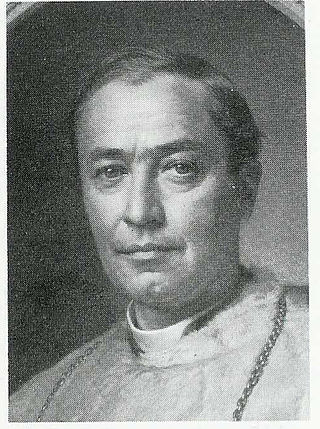
The Grand Orient of Belgium is a Belgian cupola of masonic lodges which is only accessible for men, and works in the basic three symbolic degrees of freemasonry.

Albin-Augustin Van Hoonacker was a Roman Catholic theologian, professor at the Faculty of Theology, Catholic University of Leuven, a member of The Royal Academy of Belgium and Knight of the Order of Leopold.

Johan Jozef Bonny is a Belgian prelate of the Catholic Church who has been the bishop of Antwerp in Belgium since 2009.

Edward Mary Fitzgerald was an Irish-born American prelate of the Roman Catholic Church. He served as bishop of the Diocese of Little Rock in Arkansas from 1867 until his death in 1907.

Bruges is the capital and largest city of the province of West Flanders in the Flemish Region of Belgium, in the northwest of the country. It is the sixth most populous city in the country.

Jean-Joseph Faict was the 20th Bishop of Bruges.

Male Castle, Bruges. A community of the Canonesses Regular of the Holy Sepulchre. It originated in Bruges in the 11th century, and between 1954 and 2013 was settled in Male Castle in Male, Sint-Kruis, Bruges, West Flanders, Belgium.
The following is a timeline of the history of the municipality of Bruges, Belgium.
Philippe Veranneman de Watervliet was a politician in the Southern Netherlands. During the period of the United Netherlands he was a member of the Second Chamber in the States General. He was also, between 1828 and 1830, the last mayor of Bruges before 1830, when the southern part of the country broke away to form the separate state of Belgium.

Ten Duinen Abbey or the Abbey of the Dunes was a Cistercian monastery at Koksijde in what is now Belgium. It was one of the richest and most influential religious institutions in the medieval County of Flanders. It later relocated from Koksijde to the city of Bruges.

Louis-Joseph Delebecque (1796–1864) was the 21st bishop of Ghent, in Belgium, from November 1838 until his death.

Gustave Joseph Waffelaert (1847–1931) was the 22nd bishop of Bruges in Belgium.

Julius (Jules) Raes (1884–1961), known in religion as Hildebrand and also under the pen name H. Cappaert, was a Belgian Capuchin historian and archivist.
Thomas Richey was a prominent Irish-American Anglo-Catholic priest, professor, and author in the Episcopal Church. He was born in Newry, County Down, in Ireland and had settled in Pittsburgh by 1847, following his graduation at 16 from Queen's College, Belfast. Richey was a tutor at St. James College, Hagerstown, Maryland under John Barrett Kerfoot from 1848-1851. He was graduated from the General Theological Seminary of the Episcopal Church in 1854 and ordained to the priesthood by Bishop Horatio Potter in 1855.












